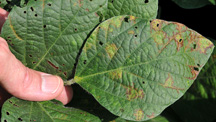Plant pathologist: Growers should be aware of new soybean virus
November 4, 2013
 |
|
Foliar symptoms of soybean vein necrosis virus. (Purdue Entomology photo/John Obermeyer) |
WEST LAFAYETTE, Ind. - Soybean vein necrosis virus has been confirmed in Indiana for the second consecutive year as plant pathologists continue to study the relatively new disease to determine how it might affect the plants and their yields.
The viral disease is a Tospovirus and was first discovered in Tennessee soybean fields in 2008. Soybean vein necrosis virus, or SVNV, has now been detected in 16 states across the southern and north-central regions of the United States.
"This is a new disease, so we're learning about what potential impact it might have on yield," said Kiersten Wise, Purdue Extension plant pathologist. "It's important for growers to be aware of this disease because it can look like many other common diseases that we see in soybean fields."
Common diseases such as brown spot, downy mildew and sudden death syndrome can all be mistaken for SVNV, so Wise said it's important for growers to know the difference.
"We want growers to be aware of what they have in their fields, and also to prevent any unwarranted management if they're trying to manage a different disease," she said.
Symptoms of SVNV begin with vein clearing followed by chlorosis, appearing as light green to yellow blotchy patches near the main vein of the leaf. Leaves might appear scorched, and affected leaf tissue might die during late stages of infection.
Tiny, winged insects called thrips transmit the virus from plant to plant. Adult thrips, about one-sixteenth of an inch long, have yellow bodies, dark thoraxes and two black crossbands on their forewings. They feed on plant juices primarily on the undersides of leaves and pollen when flowers are present.
Thrips are in soybean fields every year, and damage from the insects alone is usually insignificant.
Because SVNV is so new to Indiana soybean farmers, Wise said she and her colleagues are studying and monitoring the disease.
"We're in the record-keeping phase," Wise said. "The incidence of SVNV in soybean fields and the economic impact, if any, on soybean production has not been determined in Indiana."
Since SVNV is spread by thrips, she said, it's critical to monitor insect vector populations in the region and state to anticipate future epidemics.
Growers should also pay attention to where they have seen the disease, what soybean varieties it affected, and what management practices were used in the affected fields.
Wise said that a group of Midwestern researchers will undertake studies to understand the virus, how it's transmitted, and help determine if it can cause yield loss. The North Central Soybean Research Program has provided funds to develop Extension documents to help growers understand the disease. These materials will be released this winter.
Writer: Amanda Gee, 765-494-8402, agee@purdue.edu
Source: Kiersten Wise, 765-496-2170, kawise@purdue.edu
Ag Communications: (765) 494-2722;
Keith Robinson, robins89@purdue.edu
Agriculture News Page

